|
Events convened on Thursday,
16 December 2004
|
|
US climate action: Progress in Congress,
States and business
Presented by the US Climate Action
Network (USCAN)
|
|
|
|
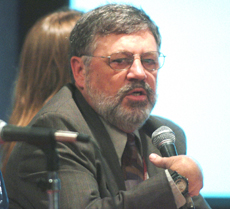 |
|
Tom Jacob, DuPont, said
there is increasing recognition of the
legitimacy of environmental concerns in
the US, and noted that many companies
are joining progressive international
business groups such as the World
Business Council for Sustainable
Development |
|
Alden Meyer, Union of Concerned
Scientists, listed voluntary
business initiatives and state-level
actions such as the West Coast
Governors’ Global Warming
Initiative, and California’s
regulatory standards for vehicular
emissions reductions. He said
benefits of such policies include
building public demand for climate
actions and demonstrating the
cost-effectiveness of feasible
solutions.
Ken Colburn, Northeast States for
Coordinated Air Use Management,
discussed climate-relevant State
legislation and policies. He noted
ongoing litigation regarding the
authority of the US Environmental
Protection Agency to regulate carbon
emissions, and said California’s
“Pavley law” requires a 22 %
reduction in vehicular emissions by
2012, and has been challenged in
court by the automobile industry.
Frank Pavley, California State
Assembly, delivered a telephone
statement, stressing the commitment
of California’s legislators to
developing a climate policy, and
listing efforts to reduce emissions,
promote fuel cell partnerships, and
increase solar power utilization.
She said it is feasible to reduce
total emissions by 30% by 2016, and
noted that 80% of Californians are
willing to pay for such reductions.
|
|
Tom Jacob, DuPont,
said his company
reduced operational
non-carbon dioxide
GHG emissions by 50%
between 1990 and
2000. Comparing
European and US
industry, he
observed that an
environmental
precautionary
principle prevails
in Europe and an
economic
precautionary
principle reigns in
the US. Jacob
stressed that
voluntary emissions
reduction programmes
reap economic
benefits from
increased energy
efficiency and
reduction of
compliance costs
with governmental
regulation.
Chris Miller, US
Senate Committee on
Environment and
Public Works, said
voluntary programmes
will not reduce
emissions in the
foreseeable future,
and that
climate-related
legislation is
likely to be
distinctly
detrimental to
climate policy. He
said the Bush
administration
opposes a Clean
Power Act introduced
in the Senate and is
unlikely to defend
States against
litigation from the
automobile industry.
Jeff Fiedler,
Natural Resources
Defense Council,
said other countries
should not allow the
US to take climate
negotiations
hostage. Noting that
the US position is
unlikely to change,
he said the only
feasible option is
to continue
negotiations without
expectations of
meaningful US
participation.
Discussion: Meyer
said US$5 billion of
US investments in
research and
development have
been used to prevent
utilization of
existing
technologies, and
stressed the need
for government
incentives to market
feasible
technologies. One
participant asked
whether US industry
and the American
public are concerned
about loss of
economic
competitiveness if
other countries
shift to a low
carbon economy.
While Jacob said
concerns about
short-term
competitiveness
prevail, Colburn
noted that the
public is unaware of
such risks. Meyer
anticipated that
various
socioeconomic
sectors in the US
will decline under a
business-as-usual
scenario. Colburn
said States cannot
circumvent the
federal government
and directly
participate in a
global regime, and
Meyer noted
increasing
interaction between
States and European
and Japanese actors.
|
|
|
Options for a post-2012 global climate
regime
Presented by the Fridtjof Nansen
Institute (FNI)
|
|
|
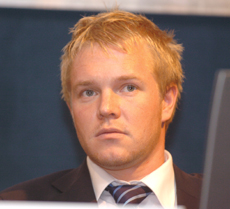 |
|
Henrik Hasselknippe, FNI, said
successful convergence of emissions
trading markets requires leadership from
a coalition of countries with emissions
trading systems, indicating that such a
coalition should commit to increasing
emissions reduction targets to generate
a ratcheting effect |
|
Taishi Sugiyama,
Central Research
Institute of
Electric Power
Industry, introduced
the project
“Scenarios for a
Post-2012
Framework,”
indicating that
post-2012 steps
should include cap
and trade,
technological
assistance and human
development. He
indicated that the
“cap first” scenario
aims to have
mutually reinforcing
effects on
technological
assistance and
development
cooperation.
Sugiyama outlined an
“orchestra of
treaties” scenario,
indicating this
would entail
cooperation between
countries on
technology transfer,
emissions markets,
climate sensitive
development, and the
UNFCCC. He proposed
a zero-emission
technology treaty,
stressing that
regional
technological
cooperation on
research and
development and
technology diffusion
can facilitate a
paradigm shift in
energy systems.
Sugiyama then
presented a research
on a “human
development”
scenario, indicating
that in determining
potential emissions
reduction targets
for developing
countries the
analysis
differentiated
between emissions
originating from
luxury needs and
basic human needs.
Henrik Hasselknippe,
FNI, described a
“converging markets”
scenario, indicating
that it would entail
the linking of
domestic emissions
trading markets. He
outlined a number of
possible
modifications to the
Kyoto |
Protocol to support
this scenario,
including:
procedures for
allowing credits or
allowances from
non-Parties’ trading
schemes; simple and
transparent models
for baseline
development;
sectoral targets for
developing
countries; an
expanded scope for
the Clean
Development
Mechanism (CDM); and
additional
eligibility criteria
for CDM host
countries.
John Drexhage,
International
Institute for
Sustainable
Development,
indicated that while
OECD countries are
expected to finance
the global response
to climate change,
overseas development
aid for climate
change is shrinking.
He suggested
integrating climate
change with
countries’
development
priorities, and
indicated that
foreign direct
investment
represents the most
significant source
of finance. He
indicated that
developing countries
will not consider
post-2012 reduction
targets until OECD
countries
demonstrate that
climate change
actions can be
undertaken without
damaging economic
growth, and stressed
that sinks should be
a critical component
of post-2012
commitments.
Jonathan Sinton,
University of
California, stressed
the need for policy
frameworks and
market structures on
the ground to
promote
energy-efficient
technologies, and
introduced
programmes to
promote energy
efficiency in the
public and private
sectors.
Axel Michaelowa,
Hamburg Institute of
International
Economics,
questioned whether
the CDM is capable
of overcoming the
lack of skills and
expertise as well as
weak institutional
capacity in
developing
countries, and
stressed the need to
involve more experts
in development
policy. He said
promoting technology
diffusion requires
investment and
cooperation between
policy makers, the
labor market and
technology
developers.
|
|
|
Climate Change: Insuring the uninsurable
Presented by the Hamburg Institute of
International Economics (HWWA)
|
|
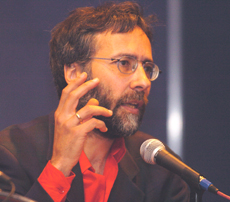 |
|
Christoph Bals, Germanwatch,
presented preliminary ideas on an
insurance-related mechanism, and invited
participants to get involved in the
discussion process |
|
Matthias Krey, HWWA, emphasized that
people in the poorest countries are
the most affected by the impacts of
climate change, noting that the
Alliance of Small Island States has
already presented a proposal for an
international insurance pool in
1991.
Christoph Bals, Germanwatch,
overviewed problems raised by
insuring against climate-related
damages in poor countries, stressing
that countries with the least
developed insurance markets incurred
88% of the fatalities from 1980 to
2003. He said private insurance is
not sufficient due to the inability
of people in poor countries to pay
premiums, and called for
public-private partnerships. He
referred to two examples, namely the
US National Flood Insurance Program
and the Turkish Catastrophe
Insurance Pool, which comprises
different reinsurance layers,
including the World Bank.
Sonja Butzengeiger, HWWA, raised
several issues regarding the design
of a possible insurance-related
mechanism (IRM), including insured
parties, |
|
participation modalities,
incentives for adaptation
and financing options. She
highlighted the challenge of
differentiating between
climate change and climate
variability, and suggested a
pragmatic approach to insure
heavy weather-related
damages as long as
scientific uncertainties
prevail regarding
attribution of damages to
climate change. Butzengeiger
identified UNFCCC Parties, a
UNFCCC administration fee,
the World Bank, the
insurance industry and
insurance-takers as possible
financial contributors to an
IRM. She outlined the
structure of a fund
including different layers
of insurer and reinsurers,
taking as an example the
Turkish Catastrophe
Insurance Pool.
Discussion: Participants
discussed attribution of
damages to climate change
and eligibility criteria for
participating in an IRM, and
called for further
quantification and concrete
examples of what should be
insured.
|
|
Lessons learnt from CDM implementation
in the ASEAN energy sector
Presented by the Association of
Southeast Asian Nations (ASEAN)
|
|
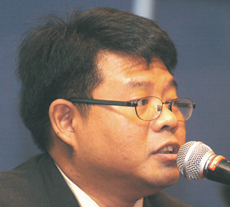 |
|
Agus Sari, Pelangi Indonesia,
said all ASEAN countries apart from
Brunei and Singapore have ratified the
Kyoto Protocol and all, except
Indonesia, have established Designated
National Authorities |
|
Nadzri Yahaya, Malaysia’s Ministry
of Natural Resources and
Environment, said there is no common
position among ASEAN countries on
the Clean Development Mechanism (CDM),
indicating that the side event aims
to clarify the positions of various
member countries.
Mark van Wees, Capacity for
Sustainable Development, identified
the potential to increase the ASEAN
region’s share in the global CDM
market. Focusing on capacity
building, he said there is limited
regional exchange of experience, and
said the ASEAN could play a role in
improving the effectiveness and
efficiency of capacity building.
Liana Bratasida, Ministry of
Environment of Indonesia, said the
ASEAN region has a rich CDM
potential, and noted that the CDM
supports ASEAN’s objectives to
increase renewable energy and adopt
clean technologies.
Axel Michaelowa, Hamburg Institute
of International Economics, said in
light of methodologies approved by
the CDM Executive Board (EB) a large
|
amount of data is needed from host
countries even for small-scale CDM
project baselines. He recommended
that the ASEAN Secretariat
coordinate the provision of
information, including baseline
emission factors and common
arguments for additionality.
Anuar Abdul Rhaman, PTM Malaysia
Energy Centre, outlined Malaysia’s
national CDM approval process,
including appraisal of projects’
contribution to technology transfer.
Agus Sari, Pelangi Indonesia, said
an ideal national CDM approval
process is efficient and simple. He
emphasized that it is not the
Designated National Authority’s
(DNA) role to decide whether a CDM
project is additional or feasible,
and said stakeholders should be able
to challenge DNAs’ decisions.
Eron Bloomgarden, Ecosecurities,
said the ASEAN region has strong CDM
potential in renewable energy,
energy efficiency, biofuels,
landfills and gas flaring, but noted
that ASEAN countries differ in terms
of commercial and political risks.
|
|
French action in the field of climate
change
Presented by the French Government
|
|
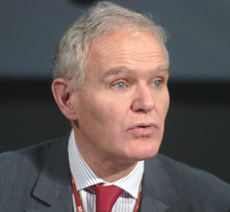 |
|
Serge Lepeltier, Minister of
Ecology and Sustainable Development,
said France’s research beyond 2010 will
focus on the development of clean
technologies, including renewable
energies and carbon sinks |
|
Serge Lepeltier, Minister of Ecology
and Sustainable Development of
France, provided an overview of
France’s climate-related policies
within the EU framework,
highlighting the 2004 Climate Plan,
which includes action areas on
information and awareness raising,
research on clean technologies,
transportation, buildings, industry,
energy and waste, and sustainable
agriculture and forests. Minister
Lepeltier noted that France has
already stabilized its GHG emissions
below those of 1990.
Christian Brodhag, Ministry of
Ecology and Sustainable Development,
outlined France’s measures to
implement its climate-related
commitments, including the
establishment of a GHG inventory,
technical and financial cooperation
to develop Joint Implementation (JI)
and CDM projects, the inclusion of
an Environment Charter in the
Constitution, and work on synergies
within the national strategy on
sustainable development.
Philippe Meunier, Interministerial
Mission on the Greenhouse Effect,
stressed that France has decoupled
economic growth from energy
consumption, but noted the need for
an integrated strategy looking |
|
beyond 2050. He highlighted France’s
activities to reduce GHG emissions,
including the provision of financial
and technical support to JI/CDM
projects and participation in
emissions trading systems.
Mustapha Kleiche, French Agency for
Development (AFD), said AFD’s work
in the field of climate change
relies on both financial and
technical tools. He noted that
assistance tends to focus on
transport, waste and energy
consumption, and be concentrated in
sub-Saharan Africa and the Indian
Ocean. He explained that assistance
approaches differ between overseas
territories and foreign countries,
and provided examples of assistance
to projects related to energy
consumption, among others.
Marc-Antoine Martin, French Global
Environment Facility (FFEM), said
criteria for FFEM’s assistance
include innovation, sustainability
and social acceptability, and noted
that the FFEM uses investments funds
and carbon funds, and prioritizes
projects in Africa and the
Mediterranean. He stressed the need
to, inter alia, strengthen
governance, integrate projects in
national strategies, internalize
costs, and develop partnerships and
networks.
Franck Jesus, Ministry of Economy,
Finance and Industry, presented his
ministry’s support tools in the
field of climate change. He reviewed
institutional and financial support
to JI/CDM projects, including
capacity building for the
development of Project Design
Documents. He said to date
assistance has focused on waste and
methane recovery. |
|
Options for the second commitment period
of the Kyoto Protocol
Presented by the Government of Germany
|
|
 |
|
Niklas Höhne, ECOFYS, outlined a
“common but differentiated convergence”
approach that would seek convergence of
all countries’ emissions to the same
level, and defer the obligation of
developing countries to undertake
mitigation commitments |
|
Martin Weiß, Germany’s Federal
Environment Agency, considered
options for the post-2012 period,
advocating a combination of
bottom-up and top-down approaches
and grounding policy on the concept
of technological feasibility. He
said preventing a global temperature
rise of 2˚C requires maintaining GHG
concentrations below 450 parts per
million (ppm) and leaves very narrow
margins for delaying emissions cuts
or exempting countries from
participation. He recommended
introducing flexible participation
rules, setting “positive binding
targets” without non-compliance
penalties for non-Annex I countries,
and extending the scope and scale of
the CDM.
Niklas Höhne, ECOFYS, outlined three
approaches to designing
international policy for the second
commitment period under the Kyoto
Protocol. He said a “common but
differentiated convergence” approach
would involve only countries with
high levels of GHG emissions, seek
convergence of all countries’
emissions toward the same level,
grant a deferral for developing
countries, and make developing
countries’ participation contingent
on compliance by developed
countries. Höhne also outlined a
Triptych approach that relies on
sharing sectoral emissions |
|
allowances between countries. He
said reaching the 450 ppm target
using this approach would allow
emissions growth above 1990 levels
in most developing countries,
require 20-40% reductions in
developed countries, and involve
reducing global emissions by 60% in
the electricity sector, 70% in
agriculture, and 90% in fossil fuel
production.
Höhne outlined a compromise proposal
without short-term policy
commitments, but including moderate
near-term emissions targets,
long-term absolute emissions
reductions using the Triptych
approach, long-term technology
development, and the complete
elimination of deforestation. He
said such an approach takes into
account national circumstances but
is complex, requires prolonged
decision making at the international
level, and entails the risk of
delaying achieving the stabilization
targets. Regarding appropriate
negotiation strategies, he stressed
that the EU’s continued leadership
is crucial, and recommended
extending the EU Emissions Trading
Scheme to US States, intensifying
dialogue with developing countries,
building coalitions on renewable
energy, and building scientific
consensus on future climate policy. |
|
Climate change litigation: Who is doing
it, why is it happening and how serious
is it?
Presented by Friends of the Earth
International
|
|
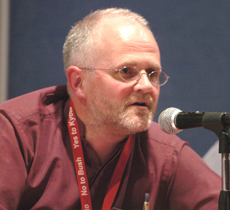 |
|
Peter Roderick, Climate Justice
Programme, said climate change is
already threatening lives and legal
systems should respond to the problem |
|
Peter Roderick, Climate Justice
Programme, outlined ten climate
change-related legal actions: five
public law cases in the US,
Australia and Germany; a civil law
case in the US; a petition by the
Inuit people to the Inter-American
Commission on Human Rights; and
three public international law
petitions by developing countries to
the UN Educational, Scientific and
Cultural Organization concerning
climate impacts on World Heritage
sites.
Myles Allen, University of Oxford,
said establishing causality is a
prerequisite for legally
ascertaining damages. Discussing
quantification of scientific
uncertainty, he indicated that past
anthropogenic GHG emissions caused
at least 50% of the 2003 heat wave
in Europe.
Ken Alex, State of California
Department of Justice, discussed a
civil lawsuit filed by eight States
and New York City in the US Federal
Court against the five largest
emitters of carbon dioxide in the
US. He said the |
|
claimants seek injunctive remedies,
namely reductions in the defendants’
emissions and a declaration that
carbon dioxide causes global warming
and is a public nuisance.
Donald Goldberg, Center for
International Environmental Law,
said the Inuit people are planning
to file a petition to the
Inter-American Commission on Human
Rights against the US, arguing that
global warming violates their rights
to life, residence, the
inviolability of their homes, health
and well-being, culture and
property. He emphasized that the
Commission has already recognized
that environmental issues fall
within the ambit of human rights.
Discussion: The panelists
highlighted the difference between
legal and scientific uncertainty,
and expressed their confidence that
climate-related science is
sufficiently unambiguous for legal
purposes. Panel Chair Farhana Yamin,
University of Sussex, noted the
absence of the precautionary
principle from current discussions,
reminding participants that it had
played an important role in early
negotiations. |
|
The world of work in climate
implementation and adaptation
Presented by the International
Confederation of Free Trade Unions (ICFTU)
|
|
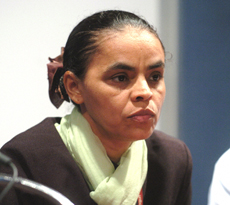 |
|
Marina Silva, Brazil’s
Environment Minister, emphasized the job
potential of the promotion and
development of renewable energies |
|
Lucien Royer, ICFTU, said the panel
includes trade unions representing
200 million workers, and highlighted
growing awareness about climate
change among them. He called for an
increased focus on employment within
the UNFCCC to encourage workers’
involvement in the climate change
issue, stressing that this would
have a fundamental impact on poverty
alleviation.
Sophie Dupressoir, European Trade
Union Confederation (ETUC),
emphasized that trade unions had
supported the Kyoto Protocol in the
EU, while industrial associations
had opposed it. She noted the need
for solidarity with people in
developing countries, and said the
social systems in Europe will help
addressing the adverse effects of
climate change policies. She
explained that one of ETUC’s
priorities is to study the impacts
of climate change and mitigation
policies on employment levels and
the employment market. |
|
|
Marina Silva, Brazil’s Environment
Minister, underscored the need to
train and educate workers. She said
Brazil has adopted sustainability
criteria to ensure that CDM projects
contribute to the broader objectives
of sustainable development, and
emphasized that CDM projects must:
promote local sustainability issues;
improve working conditions and lead
to net gains in employment;
contribute to an equitable
distribution of wealth; and promote
technical capacity building.
Iván González, Regional
Inter-American Organization of
Workers, and Aurelio Savino,
Argentina’s Environment Secretary,
presented their views on the world
of work in climate implementation
and adaptation. Note: These
statements cannot be reported on due
to lack of translation. |
|
Interlinkages between climate change and
multilateral environmental agreements
Presented by the United Nations
University (UNU)
|
|
 |
|
Victoria Lichtschein, Ramsar
Convention, said the challenge is to put
synergies between MEAs into practice,
noting that the Pantanal wetlands
provide an excellent case study |
|
Bradnee Chambers, UNU, said
exploiting interlinkages between
multilateral environmental
agreements (MEAs) requires the
effective use of synergies between
environmental issues, and listed
benefits, including increased
robustness, improved compliance,
strengthened implementation,
maximized cost-effectiveness, and
relief of procedural and managerial
burdens. He highlighted the lack of
scientific data on how interlinkages
work in practice.
Halldor Thorgeirsson, UNFCCC,
explained that the UNFCCC Subsidiary
Body for Scientific and Technical
Advice participates in a Joint
Liaison Group with the Executive
Secretaries and Chairs of the
subsidiary bodies of the Convention
on Biological Diversity and the
Convention to Combat
Desertification. He stressed the
importance of informal links for
information sharing between
secretariats. He identified the need
to enhance coordination and
cooperation at the national level
among ministries responsible for
implementation. |
|
Paulo Teixeira, Pantanal Regional
Environmental Program, noted that
the Pantanal, one of the world’s
largest wetlands, is threatened by
alterations to the hydrological
cycle from climate change. He
identified synergies and
coordination as key elements of
interlinkages, and indicated that
several MEAs are relevant to the
Pantanal. He outlined the results of
a workshop on activities for the
Pantanal’s sustainable and
integrated management, identifying
the need for community-level
actions, education and training,
information sharing, stakeholder
capacity building, and the
identification of sustainable
development indicators.
Victoria Lichtschein, Ramsar
Convention, highlighted the need to
update the memoranda of
understanding concluded in 1995
between various MEAs. She
highlighted the value of technical
cooperation between MEAs’
secretariats and strengthened
cooperation between implementing
bodies at the national level.
Discussion: Participants stressed
the need for public education
regarding the goals of different
conventions in order to engage local
peoples in the development of
synergies between MEAs. |
|
|
|







